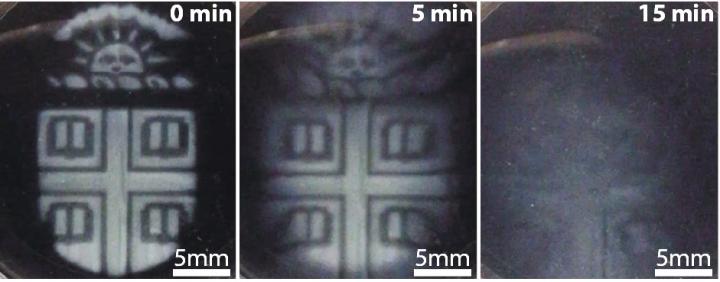PROVIDENCE, R.I., Sept. 11, 2017 — A stereolithographic technique has been developed for making 3D-printed biomaterials that can undergo controlled degradation. This technique uses noncovalent (ionic) crosslinking and could potentially enable the fabrication of adaptive and stimuli-responsive biomaterials for use in biosensing, drug delivery and tissue engineering applications.
Stereolithographic printing typically uses photoactive polymers that link together with covalent bonds — which are strong, but irreversible. A research team from Brown University experimented with using potentially reversible ionic bonds to create 3D printed structures.

Brown University researchers have found a way to 3D print intricate temporary microstructures that can be degraded on demand using a biocompatible chemical trigger. The technique could be useful in fabricating microfluidic devices, creating biomaterials that respond dynamically to stimuli and in patterning artificial tissue. Courtesy of Wong Lab/Brown University.
“The idea is that the attachments between polymers should come apart when the ions are removed, which we can do by adding a chelating agent that grabs all the ions,” professor Ian Wong said. “This way we can pattern transient structures that dissolve away when we want them to.
“It's a bit like Legos,” he said. “We can attach polymers together to build 3D structures, and then gently detach them again under biocompatible conditions.”
The team used sodium alginate, a compound derived from seaweed that is capable of ionic crosslinking, with photoacid generators and a mix of divalent cation salts to make a precursor solution for tuning the degradation kinetics, pattern fidelity and mechanical properties of the material to be printed. By using different combinations of ionic salts — magnesium, barium and calcium — researchers could create structures with varying stiffness, which could then be dissolved at varying rates.
The research demonstrated that temporary alginate structures could be useful for making lab-on-a-chip devices with complex microfluidic channels and for making dynamic environments for experiments with live cells. To demonstrate, researchers surrounded alginate barriers with human mammary cells and observed how the cells migrated when the barrier was dissolved.
Perfusable microfluidic channels were templated within an encapsulating hydrogel for T-junction and gradient devices. Degradable alginate barriers were used to direct collective cell migration from different initial geometries, revealing differences in front speed and leader cell formation.
“We can print the shape of the channel using alginate, then print a permanent structure around it using a second biomaterial,” researcher Thomas M. Valentin said. “Then we simply dissolve away the alginate and we have a hollow channel. We don't have to do any cutting or complex assembly.”
The experiments showed that neither the alginate barrier nor the chelating agent used to dissolve it had any appreciable toxic effects on the cells, suggesting that degradable alginate barriers could be a promising option for developing wound healing processes or making scaffolds for artificial tissue and organs.
“We can start to think about using this in artificial tissues where you might want channels running through it that mimic blood vessels,” Wong said. “We could potentially template that vasculature using alginate and then dissolve it away like we did for the microfluidic channels.”
The researchers plan to continue to look for ways to fine-tune the strength and stiffness properties of their alginate structures, as well as the pace of degradation.
The research was published in Lab on a Chip (doi: 10.1039/C7LC00694B).
Brown researchers have found a way to 3-D print intricate temporary structures that can be degraded on demand using a biocompatible chemical trigger. The technique could be useful in fabricating microfluidic devices, creating biomaterials that respond dynamically to stimuli and in patterning artificial tissue. The video shows a Brown University logo (roughly 10 mm across) dissolving away after applying the trigger (300x real time). Courtesy of Wong Lab/Brown University.